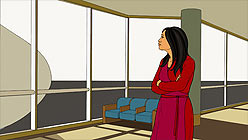I suppose sequential art is not the obvious answer for every artist participating in the “Art on Market Street” program. But for Jenifer Wofford, whose biggest drawing influence was Love and Rockets comics artist Jaime Hernandez, and who has never drawn a comic book — I guess the opportunity was too much to resist.
The format of the Market Street Kiosk project comprises six different posters (six feet by four feet each) mounted in lighted kiosks, strung along the length of Market Street from Van Ness to the Embarcadero. Wofford’s first solo Kiosk series, then, is a story in traditional comic book panels. But Flor de Manila y San Francisco is more than just the emo tale of San Francisco days and nights you might expect from our local graphic storytellers. Flor is actually a narrative of the first six years of a Filipina nurse’s sojourn in the United States, and a completely satisfying disruption of the Asian American immigrant narrative you’ve come to “joy and luck.”
Flor de Manila y San Francisco starts in 1973, when Flor, a nurse, leaves Manila for SF, and continues until 1978, when her application to bring over her family is accepted: one chapter, and one poster, for each year. In this sense, it’s sequential. However, the many panels within each poster constitute a montage of events from that year, rather than a sequentially told story. Each year is connected to a historic event, like the launch of Skylab in 1973, or the “Thrilla in Manila” Ali/Frasier fight in 1975. And each year has a theme in terms of our heroine’s assimilation into San Francisco life: disorientation, boredom, community activism, etc.
The series is interesting in itself, and I’d strongly recommend that viewers get on the hoof and walk down Market from Van Ness to Embarcadero, day or night, to view the series. (Please note: they are out of order, which doesn’t ruin the already fragmented experience, but you should adjust your expectations accordingly.) Flor is particularly interesting in light of Wofford’s recent work, which includes a series of line drawings on institutional green paper of nurses at work being pursued, absorbed, and cushioned by a sentient bank of fog; a non-sequential, textless, color narrative of a particular nurse (perhaps also Flor); and video work featuring — you guessed it — nurse characters.
Wofford’s fascination with Filipina nurses was grounded and contextualized in a riveting panel discussion she organized at Kearny Street Workshop on November 13. The panel consisted of historians, experts on: contemporary Filipino history, Filipino American history, and, very specifically, the trajectory of the Filipina nurse diaspora in the 20th century. If this sounds specific and bizarre … it’s not. The dominance of the nursing industry — worldwide — by Filipina nurses hides within it the story of the Philippines in the 20th century, major themes of recent colonization and decolonization, and some essential pieces to the puzzle of contemporary US immigration.


